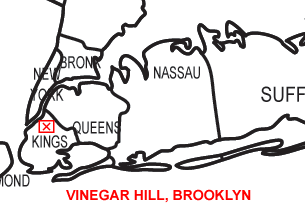 Vinegar Hill is a neighborhood located in the borough of Brooklyn on the East River Waterfront, between DUMBO and the Brooklyn Navy Yard, Long Island, New York. It is part of Brooklyn Community Board 6. The neighborhood is surrounded by the East River, the Brooklyn Navy Yard, Sands Street, and Bridge Street.
Vinegar Hill is a neighborhood located in the borough of Brooklyn on the East River Waterfront, between DUMBO and the Brooklyn Navy Yard, Long Island, New York. It is part of Brooklyn Community Board 6. The neighborhood is surrounded by the East River, the Brooklyn Navy Yard, Sands Street, and Bridge Street.
Vinegar Hill is about a four or five block square neighborhood in the east of the Manhattan Bridge anchorage. It’s a charming little area marked by brownstone buildings and Belgian-block streets that haven’t yet been asphalted. A major part of its charm lies in its ability to represent a bygone era of old but well-preserved buildings and equally ancient streets. Residents must move beyond the territorial limits of Vinegar Hills for common amenities of a modern city, but therein perhaps resides the quaint attraction of the place.
As of 2010 census, there were 1,728 people residing in the area. The median income for a household in the village is $156,892.
The neighborhood was named for a battleground in the 1798 Irish Rebellion. Its former and merged names include Irish Town or Irishtown. The name is actually an English transliteration of an Irish term meaning “hill of the wood of the berries”, rather than anything to do with vinegar. John Jackson who bought the land on which the neighborhood would later arise from the Sands brothers, for whom Sands Street is named, had targeted Irish settlers to get attractive returns on his investment.
Before the construction of the Brooklyn-Queens Expressway in the 1950’s, Vinegar Hill’s area was significantly larger, extending to Tillary Street and including the area now known as RAMBO, which has similar architecture. Most of the residences there were built between the late 1820s and the 1850s; the latter ones reflect the Italianate style.
Vinegar Hill includes the Vinegar Hill Historic District and is home to the Con Edison Hudson Avenue Station. The power plant on Hudson Avenue is less successful in keeping the peace, for it strikes a most dissonant note, not only in terms of architecture, but also by its enveloping hum. Ironically this industrial sore is an exception to the area’s residence in the past, as it has upgraded its pollution control systems, egged on by the Environmental Protection Agency and a local pressure group.
Most of Hudson Avenue was blotted out after the el came down in 1940 by the construction of a series of housing projects, the Farragut, the Ingersoll and the University Towers Houses; only its Vinegar Hill stretch and a short block between DeKalb Avenue and Fulton Street remain. It is lined with unused storefronts that must have had a practical use at one time. Today, the residents just put plants and flags in the windows, though one resident is just a little more imaginative. Con Edison is the owner and the plant may one day even switch over to cleaner gas technology from the oil it now uses to make steam and electricity.




